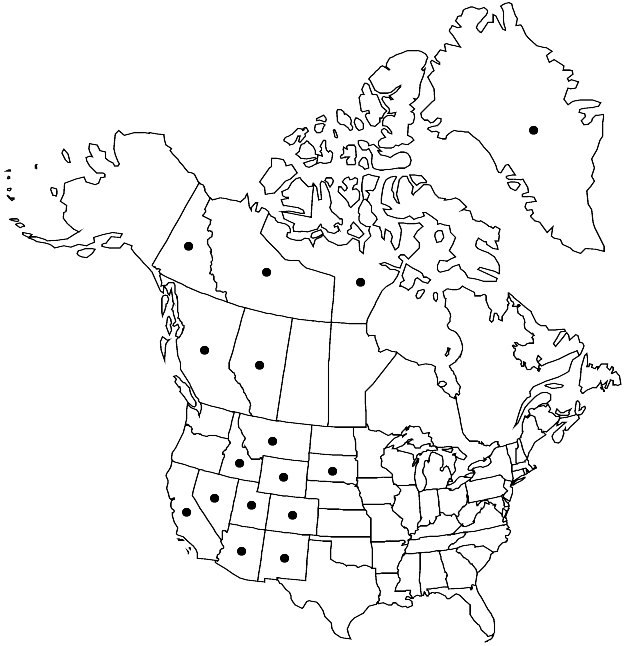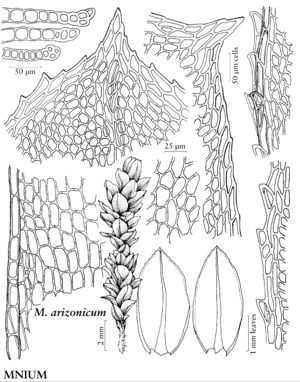Difference between revisions of "Mnium arizonicum"
Rev. Bryol. 52: 23. 1925.
FNA>Volume Importer |
imported>Volume Importer |
||
| (6 intermediate revisions by 2 users not shown) | |||
| Line 12: | Line 12: | ||
}}{{Treatment/ID/Special_status | }}{{Treatment/ID/Special_status | ||
|code=F | |code=F | ||
| − | |label= | + | |label=Illustrated |
}} | }} | ||
|basionyms= | |basionyms= | ||
| Line 30: | Line 30: | ||
|elevation=low to high elevations | |elevation=low to high elevations | ||
|distribution=Greenland;Alta.;B.C.;N.W.T.;Nunavut;Yukon;Ariz.;Calif.;Colo.;Idaho;Mont.;Nev.;N.Mex.;S.Dak.;Utah;Wyo. | |distribution=Greenland;Alta.;B.C.;N.W.T.;Nunavut;Yukon;Ariz.;Calif.;Colo.;Idaho;Mont.;Nev.;N.Mex.;S.Dak.;Utah;Wyo. | ||
| − | |discussion=<p>Mnium arizonicum is distinguished by its small size, elongate and pitted laminal cells (this is the only species of Mnium with pitted cell walls) often in distinct rows, and leaf margins composed in large part of short-linear and oblong cells with small, often single and blunt teeth. S. Flowers (1973) observed that the marginal teeth can vary widely on leaves of a single shoot, with some leaves entire and others with paired teeth.</p> | + | |discussion=<p><i>Mnium arizonicum</i> is distinguished by its small size, elongate and pitted laminal cells (this is the only species of <i>Mnium</i> with pitted cell walls) often in distinct rows, and leaf margins composed in large part of short-linear and oblong cells with small, often single and blunt teeth. S. Flowers (1973) observed that the marginal teeth can vary widely on leaves of a single shoot, with some leaves entire and others with paired teeth.</p> |
|tables= | |tables= | ||
|references= | |references= | ||
| Line 39: | Line 39: | ||
-->{{#Taxon: | -->{{#Taxon: | ||
name=Mnium arizonicum | name=Mnium arizonicum | ||
| − | |||
|authority=J. J. Amann | |authority=J. J. Amann | ||
|rank=species | |rank=species | ||
| Line 53: | Line 52: | ||
|publication title=Rev. Bryol. | |publication title=Rev. Bryol. | ||
|publication year=1925 | |publication year=1925 | ||
| − | |special status=Endemic; | + | |special status=Endemic;Illustrated |
| − | |source xml=https:// | + | |source xml=https://bitbucket.org/aafc-mbb/fna-data-curation/src/2e0870ddd59836b60bcf96646a41e87ea5a5943a/coarse_grained_fna_xml/V28/V28_356.xml |
|genus=Mnium | |genus=Mnium | ||
|species=Mnium arizonicum | |species=Mnium arizonicum | ||
Latest revision as of 21:35, 5 November 2020
Plants 1–2(–4) cm. Stems reddish brown or dark red. Leaves pale to dark green, usually contorted and spirally twisted when dry, obovate, elliptic, or sometimes obovate-spatulate, 2.5–3.5(–4.5) mm; base short- or rarely long-decurrent; margins green, 1- or 2-stratose, toothed in distal 1/3 of leaf, rarely to below mid leaf or entire, teeth paired or single, small, blunt, sometimes indistinct, occasionally long and sharp; apex acute or rounded-acute, apiculate or rarely cuspidate, cusp toothed; costa percurrent or occasionally subpercurrent, distal abaxial surface smooth or toothed; medial laminal cells elongate or sometimes oblong, (20–)25–40(–50) µm, smaller near margins, in diagonal, sometimes longitudinal rows, weakly or not collenchymatous, walls pitted, blue postmortal color absent; marginal cells short-linear or rhomboidal, sometimes mixed with linear cells, in 2 or 3 rows. Sexual condition dioicous. Seta single. Capsule yellow-brown, 2–3(–4) mm; operculum rostrate, rostrum strongly bent when dry; exostome brown, sometimes dark reddish brown. Spores 15–24 µm.
Phenology: Capsules mature summer.
Habitat: Damp soil, humus, rock, shaded cliffs
Elevation: low to high elevations
Distribution

Greenland, Alta., B.C., N.W.T., Nunavut, Yukon, Ariz., Calif., Colo., Idaho, Mont., Nev., N.Mex., S.Dak., Utah, Wyo.
Discussion
Mnium arizonicum is distinguished by its small size, elongate and pitted laminal cells (this is the only species of Mnium with pitted cell walls) often in distinct rows, and leaf margins composed in large part of short-linear and oblong cells with small, often single and blunt teeth. S. Flowers (1973) observed that the marginal teeth can vary widely on leaves of a single shoot, with some leaves entire and others with paired teeth.
Selected References
None.
